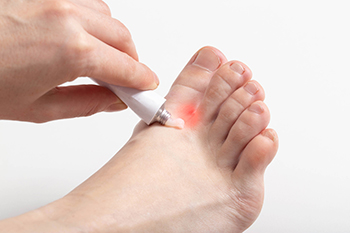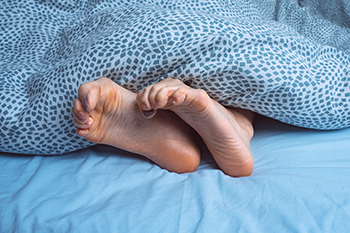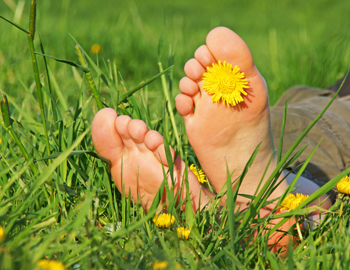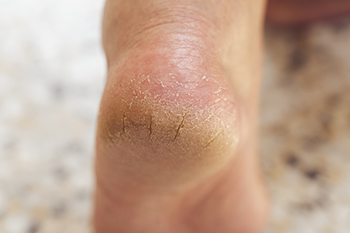Athlete’s foot, also known as tinea pedis, is a fungal infection of the skin of the feet. The fungus that causes athlete’s foot lives and thrives in warm, moist environments such as public swimming pools, locker rooms, and showers. This fungus can infect the feet through a cut or crack in the skin. Athlete’s foot is also highly contagious, and the fungus can spread from person to person through sharing personal items such as shoes, socks, or towels.
The symptoms of athlete’s foot include itching, stinging, or burning between your toes or on the soles of your feet, itchy foot blisters, and dry, cracked, or peeling skin on the feet. The infection can also spread to your toenails, leading to discoloration, thickening, and crumbling.
Through a physical examination, athlete’s foot can be diagnosed by your chiropodist based on its symptoms. Sometimes, a skin test may be ordered to confirm the diagnosis. Athlete’s foot can be treated with both oral and topical over-the-counter or prescription medications. You can prevent a fungal infection by maintaining good foot hygiene, wearing shoes when walking in public areas, avoiding sharing personal items with others, and keeping your feet clean and dry.

Athlete's foot, a common fungal infection, thrives in warm, moist environments. It is often contracted in communal areas such as locker rooms, showers, and swimming pools, where the fungus easily spreads from person to person. Wearing damp socks and tight shoes creates an ideal breeding ground for the fungus, increasing the risk of infection. To prevent athlete's foot, keeping the feet clean and dry is vital. Changing socks regularly and choosing breathable footwear can significantly reduce moisture buildup. Using antifungal powders and sprays can provide an additional layer of protection. In communal areas, wearing shower shoes helps to avoid direct contact with contaminated surfaces. Maintaining good foot hygiene and adopting these preventative measures can reduce the likelihood of developing an athlete's foot. If you have developed this condition, it is suggested that you visit a chiropodist who can effectively treat athlete’s foot.
Athlete’s foot can be uncomfortable and unsightly. To learn more about preventing and treating this condition, please consult with one of the specialists from Thornhill Foot Clinic. Our chiropodists will assess your condition and provide you with quality foot and ankle treatment.
What Is Athlete’s Foot?
Athlete’s foot refers to an infection of the skin on the feet that is caused by a fungus. This fungus is contagious and thrives in warm and moist environments. It is often spread in common areas such as public pools, locker rooms, and showers. It can also spread when sharing personal items, like shoes or towels, with an infected person.
Symptoms
The symptoms of athlete’s foot may include:
Itching, stinging, or burning of the skin on the feet
Cracking or peeling skin, especially between the toes and on the soles of the feet
Scaly, red rash on the foot
Blisters
Foul odor
Treatment
Treatment for athlete’s foot typically involves using over-the-counter topical antifungal medications on the feet. When over-the-counter options are ineffective, you may need to take prescription oral medications or topical antifungal drugs, or a combination of both.
Prevention
Preventing athlete’s foot places an emphasis on good foot hygiene practices.
You can prevent athlete’s foot by:
Washing and drying your feet thoroughly every day
Wearing shoes when walking in public areas
Not sharing personal items, like shoes or socks, with others
Wearing shoes and socks made out of breathable materials
If you have any questions, please feel free to contact our office located in . We offer the newest diagnostic and treatment technologies for all your foot care needs.
The toes are hard at work every time you stand, walk, run, hop, skip, or jump. They help to push the foot off the ground and to keep you balanced. When a toe is in pain it can negatively impact your normal daily activities. Among the numerous causes for toe pain, the chief one is trauma, such as stubbing a toe or dropping something heavy on it. This often causes severe bruising and affects your ability to bear weight. Other common causes of toe pain are bunions, hammertoes, nerve damage, and toenail problems. In addition, toe pain can be caused by gout (a type of arthritis), rheumatoid arthritis, sprains, or warts. Further causes include toenail infections, ingrown toenails, and athlete’s foot infections. Treatment by a chiropodist varies according to the underlying cause of the pain. In case of a broken or severely bruised toe, the remedy is usually to brace or splint the toe. Certain medications can be prescribed to relieve pain and injections may be administered. X-rays and imaging tests may be performed to determine the cause and severity of the toe pain. Custom orthotics may also be prescribed and fitted to counteract toe deformities or other problems. If your toe pain continues or worsens, it is suggested that you visit a chiropodist for an exam, diagnosis, and appropriate treatment options.

Toe cramps, though often dismissed as a minor nuisance, can sometimes serve as important indicators of underlying health conditions. Among them is dystonia, a neurological disorder characterized by involuntary muscle contractions that result in repetitive or twisting movements and abnormal postures. While dystonia can affect various parts of the body, including the hands, neck, and face, it may also manifest in the toes, leading to cramping or spasms. These toe cramps may occur spontaneously or be triggered by specific activities like walking or standing for prolonged periods. Individuals experiencing toe cramps in addition to other symptoms, such as muscle stiffness, tremors, or abnormal gait, should seek medical evaluation from a chiropodist, as these could be signs of dystonia. If you are experiencing frequent toe cramps, it is suggested that you contact a chiropodist for an evaluation and treatment options.
Toe pain is common and can have a variety of causes. Causes can range from a broken toe to an ingrown toenail. Many types of toe pain can be corrected, but any toe pain that inhibits your activities for an extended period should be discussed with a chiropodist. If you suffer from toe pain, please consult with one of the specialists from Thornhill Foot Clinic. Our chiropodists can help you maintain the health of your feet.
Common Causes of Toe Pain
- Trauma or fracture
- Cuts, sores, or bruises
- Rheumatoid arthritis
- Gout
- Turf Toe
- Morton’s neuroma
- Blisters
- Corns
- Bunions
- Hammertoes
- Ingrown toenails
- Plantar warts
- Athlete’s Foot
Symptoms of Toe Pain
- Toe deformity
- Burning
- Numbness
- Toenail deformity
- Wart or ulcer
- Swelling
- Redness
When to See a Chiropodist
- Bleeding or severe swelling
- Trauma, such as a broken bone
- Discoloration or extreme swelling
- Inability to bear weight
- Persistent pain
- Wounds that won’t heal
Diagnosis of Toe Pain
A chiropodist can conduct a thorough examination of the painful toe or toes in order to determine the best course of treatment. The exam may include assessing the tenderness of the area, taking an X-ray or other diagnostic test, or assessing your gait and range of motion. A discussion of what led to the advanced pain issue may follow. Included will likely be a health history, as well as a list of medications you are taking and other previous injuries you may have sustained.
Treatment for Toe Pain
With such a wide range of possible causes for toe pain, treatment can be varied in scope and length. Sometimes, the chiropodist will recommend lifestyle and activity changes. In cases of trauma or other injuries, X-rays or imaging tests will likely be used to determine the severity of the problem, particularly if any bones have been broken. Treatment may also include injections of pain-relief medication or anti-inflammatory drugs. Certain injuries will require the splinting, bracing, or wrapping of injured toes. Orthotics or special shoes may be prescribed in cases of bone deformities and gait issues. Removal of warts, calluses, and corns may be needed. In other cases, such as with patients who have diabetes or rheumatoid arthritis, ongoing treatment may be required to avoid more serious problems.

As the brisk chill of winter fades away, the arrival of spring beckons us to shed our heavy boots and embrace lighter footwear. But before slipping into sandals or strappy shoes, it is essential to ensure that our feet are primed and ready for the season ahead. Start by giving your feet some tender loving care with a warm soak to soften the skin, followed by a gentle exfoliation to slough away any rough patches. Moisturize with a rich foot cream to keep your skin supple and hydrated. Remember to trim and shape your toenails, ensuring they are neat and tidy for open-toed shoes. Pay attention to any areas of dryness or calluses, giving them extra attention to promote smoothness. Finally, pamper your feet with a relaxing massage to alleviate tension and improve circulation. If you are experiencing any type of foot condition, it is suggested that you speak to a chiropodist who can offer you effective remedies, in addition to providing you with essential foot care tips.
Springtime is the season that many people use to get back into exercising and sports. It’s also a time when foot and ankle injuries may be more common. If you have a foot or ankle injury, please consult with one of the specialists from Thornhill Foot Clinic. Our chiropodists can help you maintain the health of your lower limbs and your mobility.
Common Foot and Ankle Problems in Spring
Plantar fasciitis
Achilles tendonitis
Shin splints
Strains
Sprains
Fractures
And more
Avoiding Injury
Increase physical activity slowly and gradually
Wear comfortable, well-fitted shoes and socks
Take time to rest following a workout
Recognize and treat any injuries promptly
Treatment at Home
Rest the injured foot
Apply ice to reduce swelling
Compress the injured foot with a bandage
Elevate the foot to prevent swelling
Serious, chronic, or particularly painful injuries require medical care by a professional. If you have any questions, please feel free to contact our office located in . We offer the newest diagnostic and treatment technologies for all your foot care needs.
Spring is the season for running, baseball, tennis, and more. After a long winter of staying inside and perhaps staying sedentary, many people begin to increase their physical activity. Unfortunately, a sudden or rapid increase in physical activity can increase the risk of incurring a foot or ankle injury. Common springtime injuries include plantar fasciitis, Achilles tendonitis, shin splints, strains, sprains, and fractures.
Fortunately, there are many steps that you can take to avoid injuries. When beginning any new exercise routine, it’s important to take things slow. Do not rapidly increase the intensity or duration of your training. Instead, increase one factor at a time, gradually. For example, if you’re a runner, increase the distance that you run gradually over the course of several weeks or months. Take breaks in between workouts to allow yourself time to heal properly. It’’s equally as important to be wearing the right shoes. Choose shoes that are comfortable, fit well, and offer support.
If you do get injured or begin to notice subtle signs of injury, such as pain during physical activity, seek the care of a chiropodist. While you wait for your appointment, you can also take measures to reduce pain at home by resting the injured foot, applying ice, and compressing and elevating it. A chiropodist will be able to diagnose the injury and find the right treatment for you.

Excess weight can exert significant strain on the feet, leading to a host of complications that can affect mobility and overall foot health. The added pressure increases the risk of developing conditions such as arthritis, particularly in weight-bearing joints like the ankles and knees. Heel pain, commonly associated with conditions like plantar fasciitis and heel spurs, often worsens with excess weight, as it puts undue stress on the plantar fascia. Additionally, carrying excess weight can contribute to arch problems like flat feet or fallen arches, leading to discomfort and instability while walking. Moreover, obesity is a significant risk factor for diabetes, which can result in nerve damage and poor circulation in the feet, increasing the likelihood of foot ulcers and infections. If you carry excess weight and it is impacting your feet, it is suggested that you schedule an appointment with a chiropodist for personalized guidance and interventions to manage foot conditions exacerbated by weight, so as to promote better foot health and mobility.
Being obese affects every part of your body, and your feet are no exception. Because they bear the full weight of your body as you go about your daily life, your feet are under a lot of pressure. Carrying excess weight can strain the feet and cause a variety of unpleasant side effects. If you are obese and concerned about your foot health, please consult with one of the specialists from Thornhill Foot Clinic. Our chiropodists can help you maintain the health of your lower limbs and your mobility.
Obesity can:
Cause foot pain
Increase the risk of foot and ankle injuries
Reduce mobility
Make the feet wider
Flatten the arch
Make gout more likely
Make arthritis more likely
Increase the risk of diabetes
Your chiropodist may suggest lifestyle changes to address foot and ankle problems that are caused by or affected by obesity. These may include changes to your diet, exercise, and footwear, as well as wearing orthotics. The treatments for specific injuries or health problems will vary depending on what they are, but weight loss is often suggested to decrease strain on the feet. If you have any questions, please feel free to contact our office located in . We offer the newest diagnostic and treatment technologies for all your foot care needs.
Obesity can affect the feet in a variety of ways. Your feet bear the weight of your body, carrying you through life. When the feet are under immense strain from excess weight, they are more prone to both chronic and acute injuries. Over time, the pressure from excess weight can cause the feet to flatten and widen as the arches of the feet slowly collapse. This can not only increase your shoe size, but also lead to foot pain, difficulty walking, and a dysfunctional gait or walking pattern. A variety of foot and ankle injuries are common in obese individuals. These include plantar fasciitis and posterior tibial tendonitis, which can both become chronic. The reduced mobility from foot pain can also decrease your quality of life, make it more difficult to exercise, and lead to further weight gain.
Obesity is also associated with a host of systemic health complications that can affect the feet. Obese people may be more at risk of developing gout and arthritis, which damage the joints. There is also an increased risk of diabetes and poor circulation. Together, these conditions can lead to the development of diabetic foot wounds, which heal slowly and poorly and can cause serious health complications should they become infected.
Making healthy lifestyle changes is one way to prevent the foot problems associated with obesity. Reduce weight (and the risk of gout) by eating a healthy diet and exercising. Wear shoes that fit properly and support your feet. Your chiropodist may suggest orthotics, medications, or other treatments to address any foot pain and to improve your overall mobility and quality of life. To learn more, consult with a chiropodist near you.

Cracked heels, medically termed heel fissures, are characterized by dry, flaky skin and fissures, or splits, in the skin around the heels. This condition often occurs when the skin on the heels becomes excessively dry and loses its elasticity, leading to cracks that can be painful and unsightly. Several factors contribute to the development of cracked heels, including prolonged standing, walking barefoot, wearing open-back shoes, or exposure to harsh weather conditions. Additionally, factors such as obesity, diabetes, and certain skin conditions like eczema or psoriasis can increase the risk of cracked heels. Lack of proper foot care, including inadequate moisturizing or exfoliation, can worsen the problem. Left untreated, cracked heels may deepen, leading to bleeding, infection, and discomfort while walking or standing. If you have cracked heels, it is suggested that you schedule an appointment with a chiropodist who can successfully treat this condition by prescribing medication.
Dry, cracked heels are more than a cosmetic inconvenience. For many people, they are uncomfortable, deep, painful, and may even bleed. If you suffer from cracked heels, please consult with one of the specialists from Thornhill Foot Clinic. Our chiropodists can help you maintain the health of your lower limbs and your mobility.
Causes
Prolonged standing
Wearing open-back shoes
Wearing shoes that don’t cushion the heels
Living in a cold or dry climate
Taking long, hot showers
Not moisturizing the heels
Eczema
Psoriasis
Palmoplantar keratoderma
Juvenile plantar dermatosis
Treatments
Soaking the feet
Exfoliating with a pumice stone
Moisturizing the heels
Wearing closed-back shoes that cushion heels
Avoiding prolonged standing
Taking warm, rather than hot, showers
Treating underlying skin conditions
While milder cases of cracked heels can be treated at home, some patients present with deep, painful, bleeding heel fissures that are at risk of becoming infected and may require medical care. Additionally, patients with diabetes or any other conditions that affect the immune system should be monitored by a chiropodist.
If you have any questions, please feel free to contact our office located in . We offer the newest diagnostic and treatment technologies for all your foot care needs.

